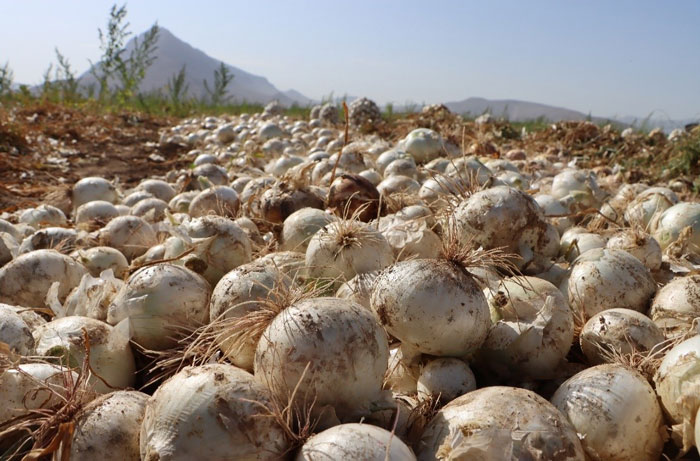The Cooperation of Nano Vahed Sanat Persia Company with the Agricultural Jihad Organization of Isfahan County for the Application of BioGME Technology in Eastern Isfahan Province
In order to cooperate with government organizations and knowledge-based companies, several meetings were held in the presence of Jihad managers of Isfahan County at Nano Vahed Sanat Persia Company HQ. The outcome of these meetings was holding an orientation session for the leading farmers of East Isfahan at the Isfahan Office. In this session, BioGME technology was introduced to farmers and some farmers volunteered to use BioGME technology. Parcels were visited in the Eastern Isfahan and expert surveys were carried out, and the BioGME technology plan was implemented in several lands.
Problems of Lands in Eastern Isfahan
The high salinity of soil and water, as well as the high percentage of soil lime, are among the most important factors limiting production in the agricultural sector of Eastern Isfahan. Observations indicate that in areas of Eastern Isfahan, the soils are classified as saline and alkaline. It is worth mentioning that due to the indiscriminate extraction of the underground water tables in the area, the volume of the underground water table has decreased drastically and the phenomenon of subsidence has intensified.
More than a decade ago, Isfahan was responsible for a large part of the country’s grain and wheat production. The wheat produced in Isfahan is one of the highest quality varieties. Wheat is a strategic crop which economic issues are less considered in its cultivation and self-sufficiency is more important in its production. However, due to the drying up of Zayandeh Rood River, the cultivation of wheat and grain in the east of Isfahan has been lost. Most of the cultivation in East Isfahan is about 60% wheat cultivation and 25% safflower cultivation, the most safflower cultivation being in Rudasht area and the remaining 15% is orchards and root crops such as alfalfa. Currently, the crops production in eastern Isfahan has decreased by about 70%.
Currently, Isfahan does not have an acceptable rank in the cultivation of grain and wheat, but it has taken the second rank in the production of flowers and melon patch crops (cantaloupes), the third rank in the production of potatoes and melons, the fourth rank in the production of vegetables, and the sixth rank in the production of fodder corn. Preventing soil erosion, reducing salinity and soil lime preserves the capacity of soil in agricultural production. In this regard, preventing desertification and increasing soil fertility will increase food security. By preserving the agricultural land and the optimal use of water and soil resources, the Eastern Isfahan lands abandonment can be prevented. The BioGME project of Nano Vahed Sanat Persia Company was implemented in collaboration with Isfahan Agricultural Jihad in onion and barley fields to reduce soil salinity, increase performance and improve production in North Baraan area east of Isfahan. In this regard, Messrs Ahmadi and Dehghan, as the leading farmers in the area, promoted their agriculture with the BioGME method. In connection with the onion agriculture in the Eastern Isfahan, as other farmers in the control group in the same area harvested about 20 tons of onions per hectare, onion harvesting with a BioGME plan on Mr. Ahmadi’s farm reached 60 tons per hectare. Regarding barley cultivation in East Isfahan, where Mr. Dehghan implemented the project in his farm, evidence suggests that the weight of 100 treated barley seeds had about 37 % increased performance compared to the control seeds.Currently, Isfahan does not have an acceptable rank in the cultivation of grain and wheat, but it has taken the second rank in the production of flowers and melon patch crops (cantaloupes), the third rank in the production of potatoes and melons, the fourth rank in the production of vegetables, and the sixth rank in the production of fodder corn. Preventing soil erosion, reducing salinity and soil lime preserves the capacity of soil in agricultural production. In this regard, preventing desertification and increasing soil fertility will increase food security. By preserving the agricultural land and the optimal use of water and soil resources, the Eastern Isfahan lands abandonment can be prevented. The BioGME project of Nano Vahed Sanat Persia Company was implemented in collaboration with Isfahan Agricultural Jihad in onion and barley fields to reduce soil salinity, increase performance and improve production in North Baraan area east of Isfahan. In this regard, Messrs Ahmadi and Dehghan, as the leading farmers in the area, promoted their agriculture with the BioGME method. In connection with the onion agriculture in the Eastern Isfahan, as other farmers in the control group in the same area harvested about 20 tons of onions per hectare, onion harvesting with a BioGME plan on Mr. Ahmadi’s farm reached 60 tons per hectare. Regarding barley cultivation in East Isfahan, where Mr. Dehghan implemented the project in his farm, evidence suggests that the weight of 100 treated barley seeds had about 37 % increased performance compared to the control seeds.

بدون دیدگاه